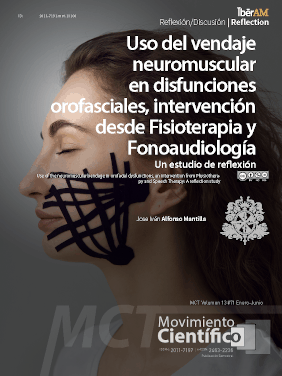Use of the neuromuscular bandage in orofascial dysfunctions
Uso del vendaje neuromuscular en disfunciones orofasciales Intervention from Physiotherapy and Speech Therapy
Main Article Content
Downloads
Publication Facts
Reviewer profiles N/A
Author statements
Indexed in
-
—
- Academic society
- N/A
- Publisher
- Bogotá: Corporación Universitaria Iberoamericana
Article Details
Acosta-Montelongo, A. PROYECTO DE INVESTIGACIÓN: Eficacia del uso del KinesiotapingR para el tratamiento de la sialorrea en pacientes adultos con patología neurológica.
Bae, Y. (2014). Change the myofascial pain and range of motion of the temporomandibular joint following kinesio taping of latent myofascial trigger points in the sternocleidomastoid muscle. Journal of physical therapy science, 26(9), 1321-1324.
Caneschi, W. F., Paiva, C. C. A. N. d., Frade, R. L., & Motta, A. R. (2014). Use of elastic bandage associated with speech therapy in the control ofsialorrhea (hypersalivation). Revista CEFAC, 16(5), 1558-1566.
Carocca Troncoso, A. (2016). Definición y validación del perfil de egreso de la carrera de Fonoaudiología UdeC. Universidad de Concepción. Facultad de Medicina. Departamento de Educación Médica,
Castro Huelves, B. d. (2014). Indicaciones, ventajas e inconvenientes y probable utilización en trastrornos de la comunicación verbal del vendaje neurotisular.
Coskun Benlidayi, I., Salimov, F., Kurkcu, M., & Guzel, R. (2016). Kinesio Taping for temporomandibular disorders: Single-blind, randomized, controlled trial of effectiveness. Journal of back and musculoskeletal rehabilitation, 29(2), 373-380.
Cárdenas Gallegos, A. M. (2013). Evaluación de los niveles de autonomía en actividades de la vida diaria en pacientes con déficit motor después de un accidente cerebro vascular de la unidad de rehabilitación neurológica del Hospital Pablo Arturo Suarez durante el periodo enero a marzo del 2013. PUCE,
da Silva, A. P., Escamez, N. E. S., Júnior, N. M., & de Andrada, M. A. (2014). Método Therapy Taping®: bandagem elástica como recurso terapêutico na clínica Fonoaudiológica. Distúrbios da Comunicação. ISSN 2176-2724, 26(4).
GonzáLez-Iglesias, J., Fernández-de-Las-Peñas, C., Cleland, J., Huijbregts, P., & Gutiérrez-Vega, M. D. R. (2009). Short-term effects of cervical kinesio taping on pain and cervical range of motion in patients with acute whiplash injury: a randomized clinical trial. Journal of orthopaedic & sports physical therapy, 39(7), 515-521.
González-Sánchez, B., Rodríguez-Mansilla, J., de-Toro-García, Á., & González-López-Arza, M. V. (2015). Eficacia del vendaje neuromuscular en el tratamiento de la sialorrea en pacientes con trastorno del espectro autista. Revista de Logopedia, Foniatría y Audiología, 35(3), 143-146.
Gutiérrez Martín, B. (2017). Efecto del vendaje neuromuscular en un paciente con sialorrea.
Jornet, M. L. (2002). Estrategias actuales para diagnóstico y tratamiento de pacientes con sialorrea. Revista Clínica Española, 202(8), 441-443.
Lesmes, J. D. (2007). Evaluación clínico-funcional del movimiento corporal humano: Ed. Médica Panamericana.
Mezzedimi, C., Livi, W., & Spinosi, M. C. (2017). Kinesio Taping in Dysphonic Patients. J Voice, 31(5), 589-593. doi:10.1016/j.jvoice.2017.01.012
Mikami, D. L. Y., Furia, C. L. B., & Welker, A. F. (2017). Addition of Kinesio Taping of the orbicularis oris muscles to speech therapy rapidly improves drooling in children with neurological disorders. Dev Neurorehabil, 1-6. doi:10.1080/17518423.2017.1368729
Navarrón Cuevas, E. L. (2003). Rehabilitación psicosocial: una perspectiva desde el modelo de ocupación humana.
Nieves Estrada, N., & Echevarría González, A. (2013). Effect of neuromuscular electrical stimulation and Kinesio taping in sialorrhea in patients with mild cerebral palsy and moderate. Fisioterapia, 35(06), 272-276.
Ristow, O., Hohlweg-Majert, B., Kehl, V., Koerdt, S., Hahnefeld, L., & Pautke, C. (2013). Does elastic therapeutic tape reduce postoperative swelling, pain, and trismus after open reduction and internal fixation of mandibular fractures? Journal of Oral and Maxillofacial Surgery, 71(8), 1387-1396.
Ristow, O., Pautke, C., Kehl, V., Koerdt, S., Schwärzler, K., Hahnefeld, L., & Hohlweg-Majert, B. (2014). Influence of kinesiologic tape on postoperative swelling, pain and trismus after zygomatico-orbital fractures. Journal of Cranio-Maxillofacial Surgery, 42(5), 469-476.
Tello, C. L., González, S. E., Blázquez, B. O., & Escacho, M. C. (2012). Eficacia del kinesiotaping en la sialorrea en niños con necesidades educativas especiales: un ensayo clínico abierto. Fisioterapia, 34(6), 275-281.











